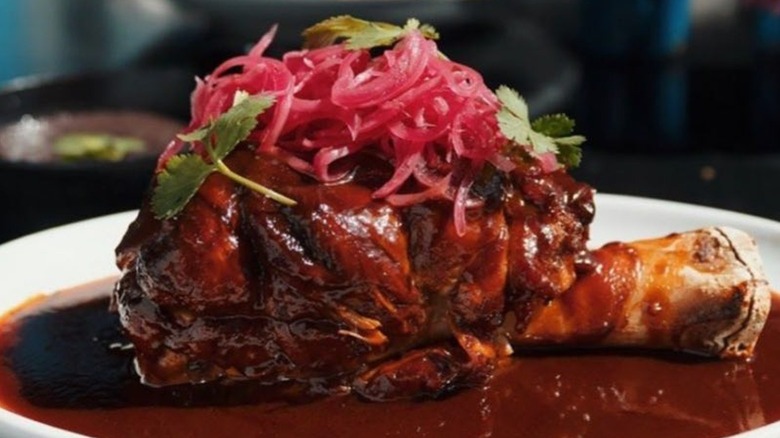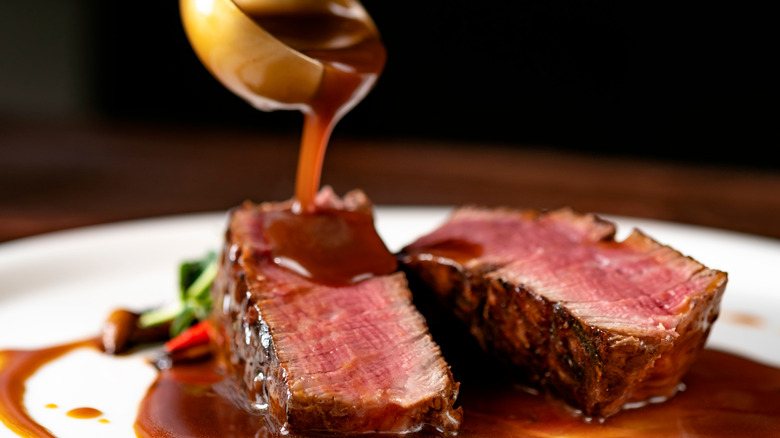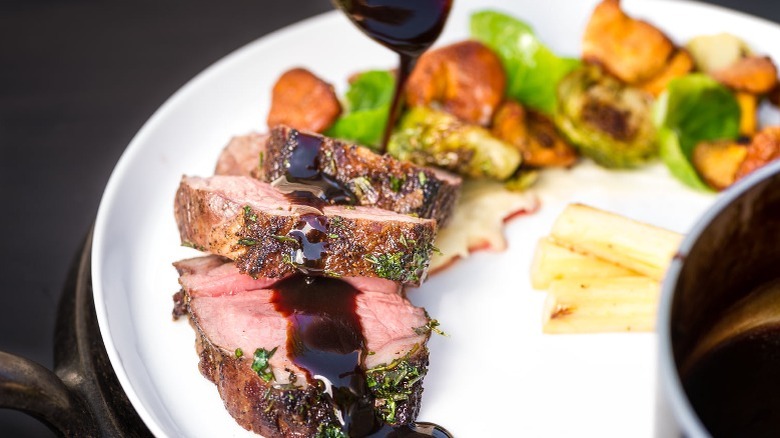Demi-Glace Vs. Glace: Is There A Real Difference Between The Two?
We may receive a commission on purchases made from links.
If you've seen cooking shows before, chances are you've heard the word "demi-glace" at least a couple of times, especially when it comes to talking about meat. While they may not appear to be "glazing" anything, you may notice that they add something that looks like a cross between gelatin and gravy into the pot — that's demi-glace. According to MasterClass's definition, demi-glace can best be described as: "... a concentrated, flavorful glaze that is used as the foundation for a number of sauces." At its most basic, it's a combination of stocks, bones (if you have any on you), aromatics, and root vegetables. In a sense, it's not too dissimilar from the gravy you may make using leftover stock and juices.
But what separates demi-glace from gravy and other sauces is that demi-glace is concentrated. That means that it's reduced over heat until the water is removed and it forms a thick "glaze" that can be added to meats and sauces. While gravy can have a thick texture, demi-glace must be reduced until it has a consistency very close to syrup.
So if demi-glace is this concentrated "glaze" of flavor, then what exactly is "glace?" Is there a real difference between demi-glace and glace, or are they just interchangeable titles for the same thing?
Glace is more concentrated than demi-glace
To start, let's clear the air on one point: Glace and demi-glace both need to be reduced in order to have that very thick consistency. Although both glace and demi-glace may share a similar texture, the key difference between them is that glace is much more concentrated than demi-glace. Demi-glace is reduced by half (the word "demi" translates to "half"), while glace is reduced by a much greater factor.
When you make demi-glace, you usually combine stock and your choice of additions (aromatics, bones, root vegetables, or sauces), and then reduce over heat until it forms a thick sauce. When you prepare a glace, however, the process is slightly different. For a glace, you must reduce your choice of stock until the sauce forms a syrup, scraping off any solids or foam that may appear on the top. As your stock reduces or boils down, the end result should be very smooth and "pure," resembling a cross between gelatin and dark gravy. Think of demi-glace as being the rich, flavorful sauce that's loaded with all sorts of vegetables and aromatics, while glace is a straight stock that's been broken down to its bare flavor essentials.
Another common trait that glace and demi-glace share is that they both take a long time to prepare, with one recipe by Robert Irvine taking an incredible eight hours to fully prepare. The results, however, are said to be worth every minute.
What can you use glaces and demi-glaces for?
So now that we understand that glace is the incredibly concentrated stock that's been boiled down to its essence, and that demi-glaze is stock that has only been reduced by half of that, the question remains: What exactly do you even use glace and demi-glace for?
Much like how gravy or pan sauces can add extra flavor to pork, chicken, or steak, so too can glace and demi-glace. A very good use of demi-glace would be to add the concentrate to your choice of soups or broths for extra flavor. If you're making French onion soup, and need a bit of meaty flavor to offset all the cheese and onions, you can add a spoonful or two of your demi-glace concentrate for a quick burst of rich meaty flavor. If you're making a simple pot roast dinner, you can add some demi-glace to the slow cooker and give the beef inside much more flavor. You can even improve store-bought gravy with a bit of glace, giving it that delicious homemade taste.
It's best to keep in mind that glace, being incredibly concentrated, contains much more flavor than demi-glace, and thus should be used sparingly to prevent changing the flavor of a dish too much. If you want to give something a boost of flavor that won't offset the dish, use demi-glace. Either way, your meal will benefit greatly from even the smallest addition of a glace.


